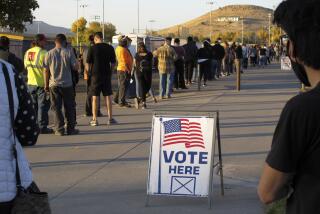Let’s Cut the Lame-Duck Season Short
- Share via
The transition that takes place between Election Day and Inauguration Day is much too long. It creates an unnecessary period of danger abroad and drift at home. And the 10-week period may actually increase the difficulty of forming a new Administration.
The most basic work of the transition time is the choosing of fewer than 100 executives for the agencies and White House, a task that only can be accomplished by the President-elect, assisted by a small group of intimate advisers.
Most of the other activities during this time amount to “make work,” tasks created to keep people busy while the inner circle goes about its business.
My recommendation is a constitutional amendment to change the inauguration date. This was done once before, in 1933, when the 20th Amendment ordered the presidential term to begin on Jan. 20, with the new Congress to start on Jan. 3. Thus there is a period of from 73 to 79 days between the time a presidential candidate is elected and takes office.
I would like to see this changeover period reduced to one month. I propose Dec. 8 as the new inauguration date, with the new congressional session to open Dec. 3. This means that the maximum number of days between the presidential election and swearing-in becomes 36; the minimum is 3.
I believe that the value of the work performed between election and inauguration is greatly exaggerated. Transition organizations are ad hoc arrangements. Yet as the apparatus becomes larger and larger, there are some who see them as an end in themselves rather than as a means to establishing more useful presidential administrations. In the 1980 transition, historian Carl M. Brauer rightly notes: “What residents and observers of Washington often saw was the blizzard of task forces, committees and teams that (then-Counselor to the President Edwin) Meese devised in part to reward, flatter, and occupy the conservative faithful.”
Transition organizations are under added stress because many of the workers in them are also hoping to find jobs in the new administration. And the production of misinformation is so substantial as to eat into the energy of the small circle of those who really are advising the President-elect. As Meese was fond of saying in 1980, “Those who know aren’t talking, and those who are talking don’t know.”
A shorter and leaner transition would mean more reliance on holdovers and members of the permanent government. The relationship between incoming personnel and the civil service depends, in part, on the degree to which the President-elect had campaigned as an outsider, running “against” Washington as did Jimmy Carter in 1976 and Ronald Reagan in 1980. But, as former National Security Council official Lincoln P. Bloomfield writes, “The outsider’s glib assumption that career civil servants will be disloyal to a new administration is an unwarranted calumny based on ignorance.”
A presidential transition, of course, is more than a 10-week-period between the election and the swearing-in. Some work (though not much) is done before the election, while most of the hard labor comes after the inauguration. A sensible transition plan, in addition to decreasing the election/inauguration period, should aim to increase pre-election planning.
The problem, obviously, is that the candidates and their inner circles must dedicate themselves to getting elected. Transition planning is low priority and even may be counter-productive if it causes squabbling among the staff. Pre-election transition operations should be encouraged, but should be placed under the aegis of the parties’ national committees and paid for with federal funds. The inducement of public money (which would be audited and could not be used for other purposes) gives new responsibilities to the national parties.
The proposed constitutional amendment has the added dividend of discouraging lame-duck congressional sessions. Since 1933, Congress has held 10 post-election sessions. At the last one, in 1982, 19% of the House members were lame ducks. There were five in the Senate.
In the opinion of Sen. Claiborne Pell, a veteran of four lame-duck sessions, they “are nearly always unproductive, sharply criticized by public and the news media, and may result in actions unrepresentative of the will of the people.”
More to Read
Get the L.A. Times Politics newsletter
Deeply reported insights into legislation, politics and policy from Sacramento, Washington and beyond. In your inbox twice per week.
You may occasionally receive promotional content from the Los Angeles Times.










